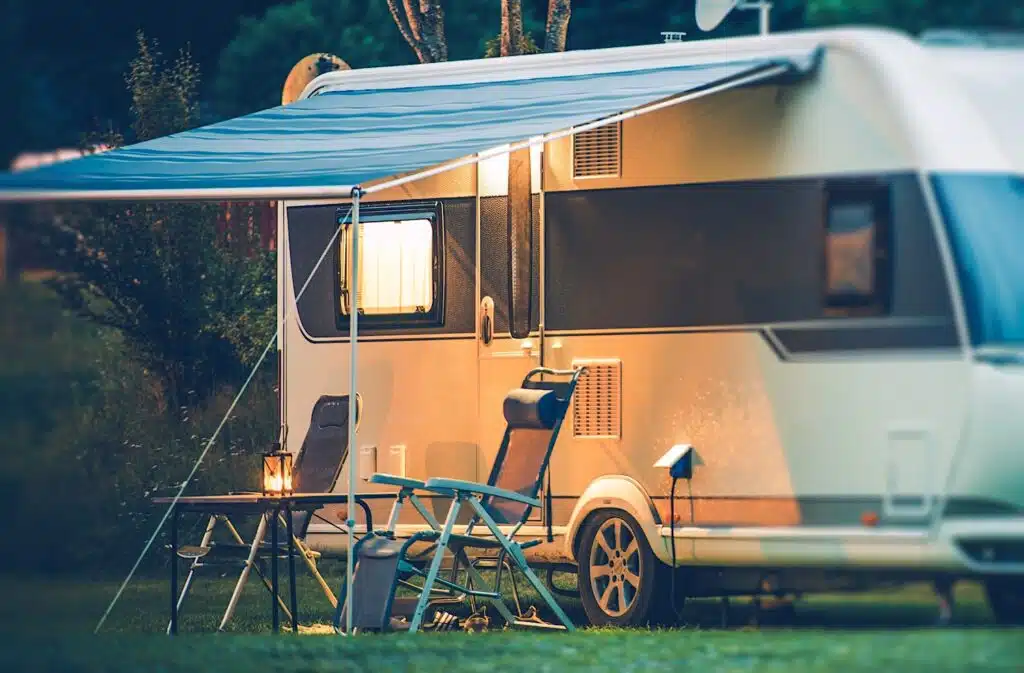Did you just get back from your RV trip or pulled your RV out of long-term storage to find your awnings are covered in tree sap on the top, mold growing on the underneath of the awning, or dirt everywhere?
Not only is mold, dirt and sap unsightly to look at, it can also start to damage your awning over time.
Because the awning allows you even more precious square footage of living space while outdoors, you don’t want to do anything that damages the protection from sun and rain.
The method and type of awning cleaner you use to clean will depend on your type of RV awning materials. For instance, the methods to clean a vinyl RV awning will differ versus an acrylic awning.

Cleaning this accessory can be easy and should be a part of your routine RV maintenance.
Regardless of your type of camper, the cleaning solutions range from homemade and DIY cleaners to store bought options.
Different Types of RV Awning Materials
Before you decide which type of cleaning method to use, you must first identify what type of awning is on your RV.
Vinyl Awnings
If you mostly use or store your RV in temperate or humid climates, many awning manufacturers suggest using a vinyl fabric.
Since vinyl is typically a tightly woven fabric, it is water resistant and provides excellent shade. However, since the material is so tightly woven, the material is not breathable and the shaded area below the awning will not be as breezy as an acrylic option.
Vinyl fabric is also resistant to mildew – but not mildew or mold proof – making it an ideal choice for someone looking for a low-maintenance option.
Acrylic Awnings
If you camp or store your RV in a warm and dry climate, such as the American southwest, awning manufacturers suggest using an acrylic awning fabric.
Due to the way the fabric is stitched, acrylic tends to be a more breathable awning option. This allows for fresh air to flow under the awning, resulting in cooler and less stuffy air.
Though acrylic awnings are more breathable than vinyl fabric, they will completely block the sun. Which makes acrylic an ideal shade solution for warm and dry climates.
Acrylic is also great at repelling water, making it possible to enjoy the outdoors during a rainy day.

How To Clean A Camper Awning
Depending on the type of fabric your camper or RV awning is made of – vinyl vs. acrylic – will determine the type of awning cleaner and cleaning process you should utilize.
How To Clean A Vinyl Camper Awning
To clean a vinyl RV awning, we suggest using a soft brush, dish soap, and water. Avoid deep or hard scrubbing of either surface of the awning.
Hard scrubbing has the potential to remove the factory applied mildew-resistant coating, which you want to preserve as long as possible.
Another option is to utilize a protectant spray. If you plan to use a protectant spray to clean your vinyl awning, verify that the product is vinyl-safe and confirm it provides UV, dust and dirt protection.
How To Clean An Acrylic Camper Awning
Cleaning an acrylic awning can be achieved by using a stiff brush, dish soap, and water. Similar to vinyl awnings, avoid scrubbing deeply, as it can remove the water-repelling finish and ruin your awning.
The second option for cleaning your camper’s acrylic awning is using a protectant spray designed to restore water repellency, but one that will not damage the fabric or factory finish.

How To Remove Mold From An RV Awning
Chemical Cleaners
For acrylic camper awnings with mold you do not use bleach for cleaning. A diluted bleach solution will remove the surface issue, but the bleach solution cannot remove the mold spores and roots that are penetrating the fabric.
To clean acrylic awnings we suggest using an antimicrobial cleaner to remove the surface mold and any deeply rooted mold spores.
However, campers with vinyl awnings can tolerate a diluted bleach solution to successfully remove the surface mold and the mold roots. A diluted water and bleach mixture applied directly to the affected area should kill the mold and dislodge it so you can remove it.
To dilute bleach, mix no more than 1 cup of bleach to one gallon of water. This is the Center for Disease Control’s (CDC) recommended dilution for killing mold.
After waiting roughly 10 minutes, use a soft brush to gently scrub away the mold. Rinse the area with clean water to remove any residual bleach solution.
A chemical alternative to bleach for vinyl awnings is also using an antimicrobial cleaner designed especially for mold.
DIY RV Awning Cleaner
If you want to avoid chemical cleaners, you can make DIY cleaners with ingredients you have in your pantry. These homemade cleaning solutions can work on both vinyl and acrylic RV awnings.
Using a combination of vinegar and baking soda can effectively remove mold and mildew.
First, soak or spray the affected area with white distilled vinegar. Allow the vinegar to stay on the moldy surface for about 5 – 10 minutes.
Then, sprinkle a generous amount of baking soda on top of the vinegar. The baking soda and vinegar might cause a fizzy reaction at this point, so do not be alarmed.
Using a soft brush, gently scrub in circular motions to dislodge and remove the mold.
This process may require a few passes but you will not have deal with nasty chemicals to get rid of mold and mildew.
How To Remove Tree Sap From An RV Awning
Camping in the woods means camping under trees. Every RVer will soon discover that forest camping is awesome until you realize that the trees drop sap, needles and leaves on your awning and your roof all day long.
Tree sap can is a sticky mess that general household cleaners or soap and water alone will not remove.
You do need to remove the sap as soon as possible. Otherwise, the sap will attract debris and create a bigger, sticky problem.
Dried sap can also create hardened bits that might tear or puncture your awning as it is rolled and unrolled.
For fresh sap or sap that has been baked in the sun you can try using a marine grade degreaser. (Also available on Walmart).
Dried tree sap that has been attached for some time is more difficult to remove. For this situation, we suggest using rubbing alcohol (also called Isopropyl Alcohol) – to spot clean the areas affected by tree sap.
Cleaning an RV awning is just one of the many routine maintenance tasks you need to perform. Be sure to see our tire pressure guide which is essential before travel days, as well as easy steps to clean your holding tank effectively.
